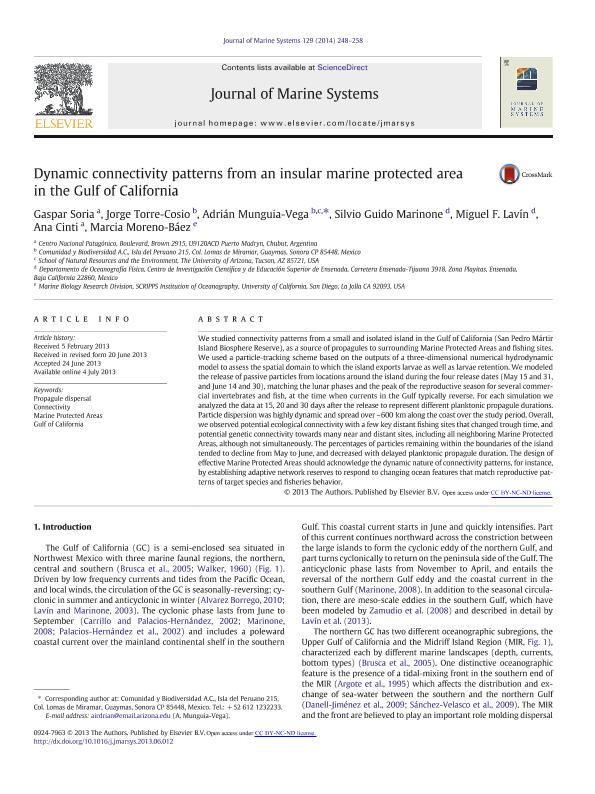Artículo
We studied connectivity patterns from a small and isolated island in the Gulf of California (San Pedro Mártir Island Biosphere Reserve), as a source of propagules to surrounding Marine Protected Areas and fishing sites. We used a particle-tracking scheme based on the outputs of a three-dimensional numerical hydrodynamic model to assess the spatial domain to which the island exports larvae as well as larvae retention. We modeled the release of passive particles from locations around the island during the four release dates (May 15 and 31, and June 14 and 30), matching the lunar phases and the peak of the reproductive season for several commercial invertebrates and fish, at the time when currents in the Gulf typically reverse. For each simulation we analyzed the data at 15, 20 and 30 days after the release to represent different planktonic propagule durations. Particle dispersion was highly dynamic and spread over ~ 600 km along the coast over the study period. Overall, we observed potential ecological connectivity with a few key distant fishing sites that changed trough time, and potential genetic connectivity towards many near and distant sites, including all neighboring Marine Protected Areas, although not simultaneously. The percentages of particles remaining within the boundaries of the island tended to decline from May to June, and decreased with delayed planktonic propagule duration. The design of effective Marine Protected Areas should acknowledge the dynamic nature of connectivity patterns, for instance, by establishing adaptive network reserves to respond to changing ocean features that match reproductive patterns of target species and fisheries behavior. We studied connectivity patterns from a small and isolated island in the Gulf of California (San Pedro Mártir Island Biosphere Reserve), as a source of propagules to surrounding Marine Protected Areas and fishing sites. We used a particle-tracking scheme based on the outputs of a three-dimensional numerical hydrodynamic model to assess the spatial domain to which the island exports larvae as well as larvae retention. We modeled the release of passive particles from locations around the island during the four release dates (May 15 and 31, and June 14 and 30), matching the lunar phases and the peak of the reproductive season for several commercial invertebrates and fish, at the time when currents in the Gulf typically reverse. For each simulation we analyzed the data at 15, 20 and 30 days after the release to represent different planktonic propagule durations. Particle dispersion was highly dynamic and spread over ~ 600 km along the coast over the study period. Overall, we observed potential ecological connectivity with a few key distant fishing sites that changed trough time, and potential genetic connectivity towards many near and distant sites, including all neighboring Marine Protected Areas, although not simultaneously. The percentages of particles remaining within the boundaries of the island tended to decline from May to June, and decreased with delayed planktonic propagule duration. The design of effective Marine Protected Areas should acknowledge the dynamic nature of connectivity patterns, for instance, by establishing adaptive network reserves to respond to changing ocean features that match reproductive patterns of target species and fisheries behavior.
Dynamic connectivity patterns from an insular marine protected area in the Gulf of California
Título:
Dynamic connectivity patterns from an insular marine protected area in the Gulf of California
Soria, Rodrigo Gaspar ; Soria, Rodrigo Gaspar
; Soria, Rodrigo Gaspar ; Torre Cosio, Jorge; Torre Cosio, Jorge; Munguia Vega, Adrián; Munguia Vega, Adrián; Marinone, Silvio Guido; Marinone, Silvio Guido; Lavín, Miguel F.; Lavín, Miguel F.; Cinti, Ana
; Torre Cosio, Jorge; Torre Cosio, Jorge; Munguia Vega, Adrián; Munguia Vega, Adrián; Marinone, Silvio Guido; Marinone, Silvio Guido; Lavín, Miguel F.; Lavín, Miguel F.; Cinti, Ana ; Cinti, Ana
; Cinti, Ana ; Moreno Báez, Marcia; Moreno Báez, Marcia
; Moreno Báez, Marcia; Moreno Báez, Marcia
 ; Soria, Rodrigo Gaspar
; Soria, Rodrigo Gaspar ; Torre Cosio, Jorge; Torre Cosio, Jorge; Munguia Vega, Adrián; Munguia Vega, Adrián; Marinone, Silvio Guido; Marinone, Silvio Guido; Lavín, Miguel F.; Lavín, Miguel F.; Cinti, Ana
; Torre Cosio, Jorge; Torre Cosio, Jorge; Munguia Vega, Adrián; Munguia Vega, Adrián; Marinone, Silvio Guido; Marinone, Silvio Guido; Lavín, Miguel F.; Lavín, Miguel F.; Cinti, Ana ; Cinti, Ana
; Cinti, Ana ; Moreno Báez, Marcia; Moreno Báez, Marcia
; Moreno Báez, Marcia; Moreno Báez, Marcia
Fecha de publicación:
07/2013
07/2013
07/2013
Editorial:
Elsevier
Elsevier
Elsevier
Revista:
Journal Of Marine Systems
Journal Of Marine Systems
Journal Of Marine Systems
ISSN:
0924-7963
0924-7963
0924-7963
Idioma:
Inglés
Inglés
Inglés
Tipo de recurso:
Artículo publicado
Clasificación temática:
Resumen
Archivos asociados
Licencia
Identificadores
Colecciones
Articulos(CCT-CENPAT)
Articulos de CTRO.CIENTIFICO TECNOL.CONICET - CENPAT
Articulos de CTRO.CIENTIFICO TECNOL.CONICET - CENPAT
Citación
Soria, Rodrigo Gaspar; Torre Cosio, Jorge; Munguia Vega, Adrián; Marinone, Silvio Guido; Lavín, Miguel F.; et al.; Dynamic connectivity patterns from an insular marine protected area in the Gulf of California; Elsevier; Journal Of Marine Systems; 129; 7-2013; 248-258
Soria, Rodrigo Gaspar; Torre Cosio, Jorge; Munguia Vega, Adrián; Marinone, Silvio Guido; Lavín, Miguel F.; et al.; Dynamic connectivity patterns from an insular marine protected area in the Gulf of California; Elsevier; Journal Of Marine Systems; 129; 7-2013; 248-258
Soria, Rodrigo Gaspar; Torre Cosio, Jorge; Munguia Vega, Adrián; Marinone, Silvio Guido; Lavín, Miguel F.; et al.; Dynamic connectivity patterns from an insular marine protected area in the Gulf of California; Elsevier; Journal Of Marine Systems; 129; 7-2013; 248-258
Compartir
Altmétricas



